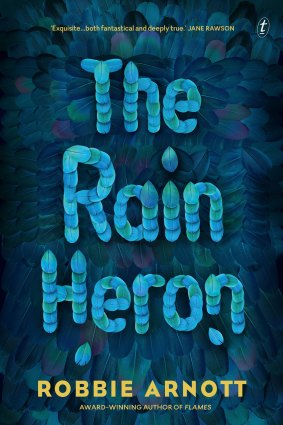This was published 4 years ago
A magical novel about the natural world that will get you thinking
By Jason Steger
In a piece in the autumn edition of Meanjin, Tasmanian author and editor Ben Walter laments that "the number of Tasmanian literary fiction writers barely needs two hands to hold it" and how Tasmanian writers are "used to being ignored, patronised and disparaged ... They're used to soldiering on in this context, and maybe they're equipped to produce unique work". One of the writers he namechecks is that of his friend, Robbie Arnott.

Robbie Arnott observes colours and textures when he walks in the Tasmanian bush. It helps with his writing.Credit: Mitch Osborne
Arnott's first novel, Flames, was a surprise and delight. It won the Margaret Scott prize in Tasmania last year, was longlisted for the Miles Franklin, shortlisted for the Victorian Premier's fiction prize and Arnott was named a Sydney Morning Herald best young Australian novelist.
Flames was a sort of Tasmanian magic realism combined with a family mystery. It was imaginative, witty and included some wonderful writing, not least the poignant story of the partnership between Karl, a tuna fisherman, and his fishing partner, a seal. It's fair to say it lived up to Walter's analysis.
His second novel, The Rain Heron, is even more rooted in the natural world. And while it also has at its heart an act of magical creation, this book is a very different beast. There is violence, cruelty, redemption and, as in Flames, strong women.
There has been a coup in an unnamed country. Ren has fled its consequences and is now living in a mountain cave, trapping animals and trading skins with Barlow, a man from the nearby village. Soon the relative tranquility of her existence is disturbed by the arrival of a group of soldiers under the command of a woman, Lieutenant Harker. Their mission: to capture the mythical Rain Heron, the bird Ren says she first saw as a child.
"The bird launched itself from the tree, trailing rain from its talons. It twirled in the windless air, shaking ice and dew across the clearing and over Ren and her grandmothers, drawing from them shivers and shrieks, before falling in a straight, fast dive into the tarn. It disappeared, but it caused no splash, made no ripples. It was as if the bird had become one with the water ..."
The heron can bring rain to parched land, bounty to barren fields, and brutal ripostes to those who threaten it. And as the various strands of Arnott's narrative meld, the heron hovers over a story of tragedy, trauma and redemption.
As in Flames there remains a balance between the real and the fantastical. "I wanted to write a book where characters who felt completely real even if they were in an imaginary country had their lives intertwined with a myth or a fable."
He hadn't given too much thought to the genders of his characters until he was well into the writing, but it was the characters' resilience that made him think of them as women.

Credit:
"They were exhibiting this calm methodical kind of resilience where they're not that fussed – as opposed to a more performative gung-ho getting on with it which is a bit more a male thing in our culture. The way they behaved, it made more sense to me that they were women."
The violence of The Rain Heron is central to Arnott's purpose.
"I wanted to write about how the violence we enact on each other bleeds out into violence against the natural world. And as we know, violence begets violence. And I wanted to show that reflected not just in the way we treat each other, but the way we treat the world around us. That really drove me while I was writing. I kept thinking ‘is this too much' but I kept returning to that what I was writing about is nowhere near as bad as what's happening in the real world."
But it would be a mistake to see The Rain Heron as a didactic novel. Yes, there's a powerful message about our dealings with the world around us, but Arnott is no preacher, he is exploring ideas rather than prescribing them. Violence, he points out, is a natural part of the world.
"The difference being that it's violence without cruelty, it's violence with purpose. You very rarely see an animal do something based on emotions."
The message is about the degradation of nature and our relationship with it. "I'm not saying this is what we need to do differently," he says. "I think if things like that are presented imaginatively it gives us a new way of looking at it. Rather than with horrible headlines and the picture of a burnt forest."
When it came to bringing the Rain Heron to life, Arnott faced the problem of making it fantastical but also tangible and real.
"What I had in mind was a creature that embodied both the beauty and savagery of nature. I wanted it to be captivating and astonishing, but also harsh and unforgiving. And I also wanted it to be completely uncaring of humanity. It was really important to me that this mythical creature was as interested in humanity as you or I would be in a button rolling down a street."
Arnott says that is how animals react to people – they don't care about us at all. "I don't like those stories where nature sides with good people over the bad people. That's not how nature works."
In trying to capture the constituent parts of his creation, he realised he had the idea of a storm in his head and as a result the sort of animal it could be. "It made sense that it would be a bird and it made sense that it would be rain. And from there I built it."
Arnott grew up in Launceston. He spent summers in a little town called Greens Beach at the mouth of the Tamar River with his extended family: "My mother, grandmother and my aunt all figure very prominently as quite matriarchal figures in our family."
These days he works as a copywriter with an advertising agency in Hobart. The nature of that work has helped him develop a strong work ethic and a thick skin when it comes to criticism.
"Advertising can be very intense, no one's looking after your feelings, no one cares if everyone hates what you've done and you've had your day ruined. You just get on with it and do it."
But when he turns to his fiction it's liberating: "I get to dive into my imagination again and make things up, because despite what they say about advertising, you're not allowed to make things up."
It's not all made up, though. His nature writing draws extensively from his observations walking in the Tasmanian bush or on Mount Cook.
Mind you, it could be a frustrating experience walking with him. He's not a bloke for a cursory glance. He likes to stop and look at things, look closely. And then, perhaps, get everyone else to look – even if they're not quite sure what they are supposed to be looking at. Colours and textures are an important part of his writing, so he wants to remember them, to get them right.
"I like to stare at something – it probably looks a bit weird – to try and imprint what it does actually look like. Yes, it looks like a group of green trees, but if you look quite clearly a lot of those eucalyptuses look quite blue. And, yes, the water looks navy but if you look closely there's a shallower patch where it's almost teal and the drops of white aren't always foamy and frothy. Sometimes they're a bit like the skim offmilk."
Arnott reckons the aforementioned Ben Walter walks about 10 times faster than he does. "I'm a dawdler," he says. Except when it comes to his writing, that is.
The Rain Heron is published by Text at $29.99.